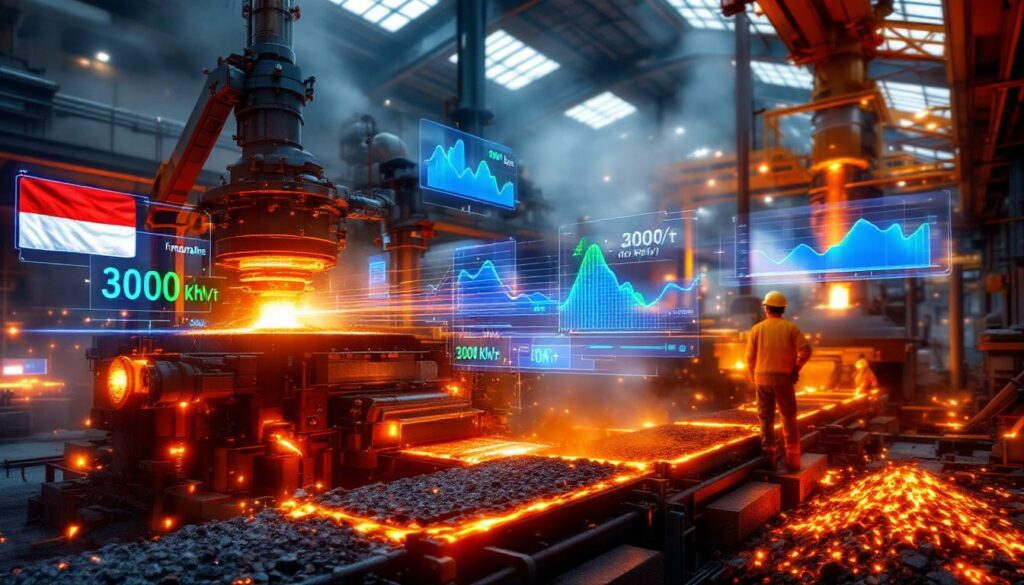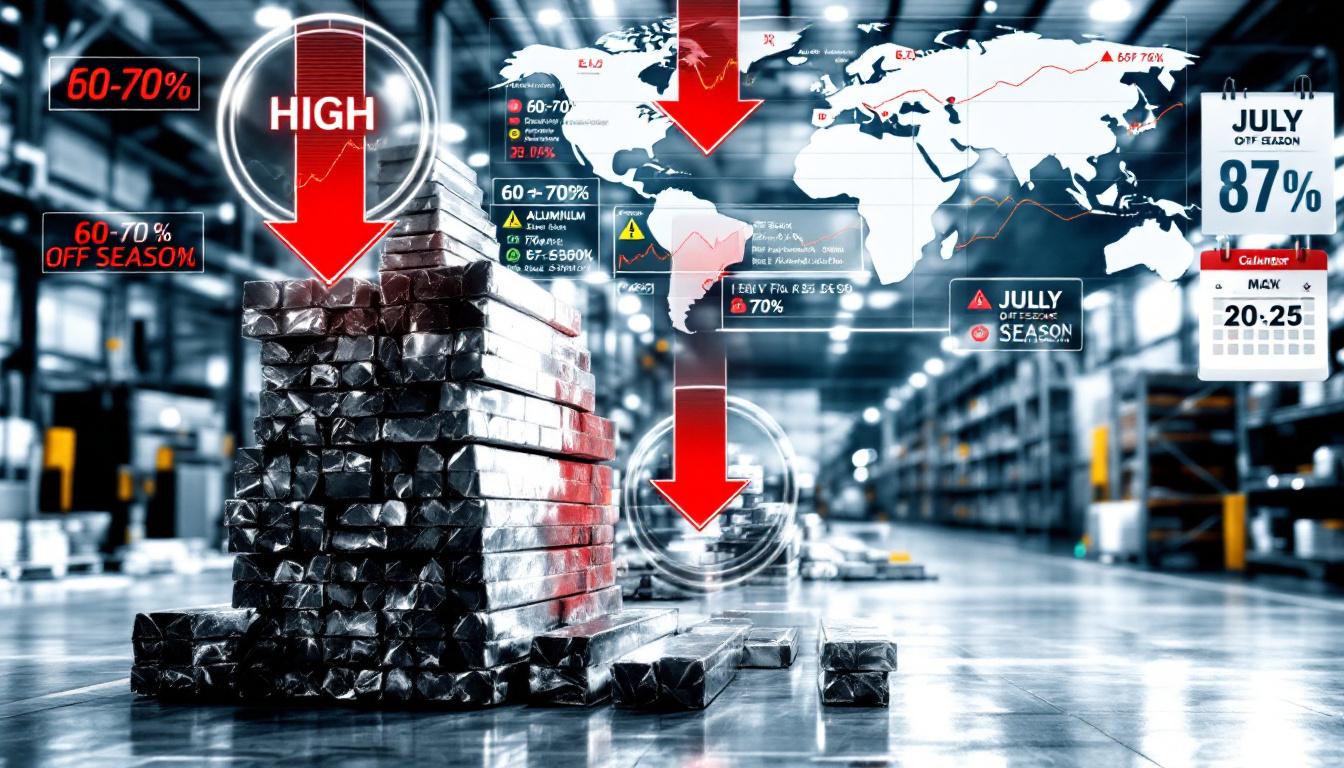The Significance of QFF's Electricity Consumption Breakthrough in Indonesian Ferrochrome Smelting
In a significant milestone for Indonesia's metallurgical industry, PT Qingfeng Ferrochrome Indonesia (QFF) has achieved what many considered impossible: reducing electricity consumption in ferrochrome smelting to below 3,000 kWh/t. This breakthrough, recorded in June 2025 at the Morowali Industrial Park, marks a historic transition from the "3xxx" range to the "2xxx" range in both physical and 50-base smelting electricity consumption for high-carbon ferrochrome production.
"The 3000 kWh/t smelting electricity consumption is a breakthrough result of the deep integration of technological innovation and lean management," stated QFF General Manager Qin Huaxiang in an announcement from Shanghai Metal Market (SMM).
This achievement is not merely a technical milestone but represents a strategic advantage for Indonesia's growing metallurgical sector. By establishing new efficiency benchmarks, QFF positions Morowali Industrial Park as an emerging hub for industry innovation trends in Southeast Asia.
Historic Achievement in Energy Efficiency
The sub-3000 kWh/t consumption level represents a paradigm shift in ferrochrome production efficiency. Traditional ferrochrome smelting operations typically consume between 3,300-4,000 kWh/t, making this breakthrough particularly noteworthy in the energy-intensive metallurgical industry.
Energy consumption in ferrochrome production has long been considered a fixed cost with limited room for optimization. QFF's achievement challenges this assumption, demonstrating that significant efficiency gains are possible through innovative process engineering and materials management.
"This marks a solid step forward for the company in transforming into a resource-conserving and environmentally friendly enterprise," noted Qin Huaxiang, highlighting the broader implications of the breakthrough.
The achievement is particularly impressive considering the high-carbon ferrochrome grade being produced, which typically requires more intensive processing than medium or low-carbon alternatives.
Strategic Importance for Indonesia's Metallurgical Sector
Indonesia's strategic position in the global stainless steel supply chain has been strengthened by this development. As the world's largest nickel producer, Indonesia has been working to move up the value chain by developing downstream processing capabilities.
This electricity consumption breakthrough provides several competitive advantages:
- Cost leadership: Lower energy costs translate to improved margins in the highly competitive global ferrochrome market
- Reduced carbon footprint: Essential for meeting increasingly stringent environmental standards in export markets
- Technology showcase: Demonstrates Indonesia's capacity for technological innovation in metallurgy
- Investment attraction: Success stories like QFF's create positive momentum for further foreign investment
The Morowali Industrial Park, where QFF operates, has become a centerpiece of Indonesia's industrial development strategy. This breakthrough reinforces its position as a hub for metallurgical innovation and sustainable transformation.
How QFF Achieved This Energy Efficiency Breakthrough
QFF's groundbreaking achievement wasn't the result of a single innovation but rather a systematic approach combining technological advancement with lean management principles. Two key technological innovations formed the foundation of this success, working synergistically to deliver results greater than the sum of their parts.
Magnetic Separation Iron Recovery Technology
At the heart of QFF's efficiency gains is an advanced magnetic separation system that precisely recovers and enriches iron-bearing materials that would otherwise be lost in slag. This technology:
- Targets valuable metals: Specifically identifies and extracts iron compounds with high precision
- Reduces furnace burden: Significantly decreases the volume of return slag entering the furnace
- Eliminates ineffective load: Minimizes material that absorbs energy without contributing to production
- Enhances raw material utilization: Improves overall recovery rates from input materials
The implementation of magnetic separation technology represents a significant advance in resource efficiency. Traditional ferrochrome smelting processes often suffer from metal losses in slag that can approach 10-15% depending on operational parameters. QFF's innovation effectively recaptures a substantial portion of this previously lost material.
"The magnetic separation iron recycling process is an innovative application guided by the lean management philosophy," explained Qin Huaxiang.
By reducing return slag volumes, the furnace operates more efficiently, with electrical energy directed primarily toward productive metallurgical reactions rather than reheating already-processed materials.
Flux Substitution Process Innovation
The second key innovation involves the partial replacement of traditional flux materials with alternative basic compounds. This seemingly simple substitution has profound implications for energy consumption because:
- Traditional flux materials require significant energy for decomposition and melting
- Alternative basic materials can achieve similar metallurgical outcomes with lower energy input
- Optimized slag performance maintains or improves product quality while consuming less energy
- Reduced total flux volume decreases the overall mass requiring heating in the furnace
This flux substitution innovation addresses a fundamental inefficiency in conventional ferrochrome production. Approximately 15-20% of energy consumption in traditional processes is dedicated solely to flux-related reactions. By optimizing flux composition and reducing volume requirements, QFF has effectively eliminated a significant portion of this energy demand.
The specific alternative flux materials employed by QFF have not been disclosed in detail, but likely involve modified ratios of limestone, dolomite, and other basic compounds customized to local raw material characteristics.
Synergistic Process Integration
What makes QFF's achievement particularly remarkable is the complementary relationship between these innovations. The reduced return slag volumes and decreased flux requirements create a virtuous cycle of efficiency improvements:
- Lower processing loads: Less material handling throughout the production chain
- Reduced transportation energy: Fewer tons moved per unit of finished product
- Decreased preparation requirements: Less crushing, screening, and preparation of raw materials
- More stable furnace operation: More consistent thermal conditions improving overall efficiency
This integrated approach demonstrates the application of lean management principles throughout the entire production process. As Qin Huaxiang noted, the breakthrough resulted from "the deep integration of technological innovation and lean management."
QFF's innovation extends beyond the smelting furnace itself to encompass raw material handling, environmental protection systems, and water circulation processes. This comprehensive approach ensures that efficiency gains in one area aren't offset by increased energy consumption elsewhere.
The Quantifiable Benefits of Reduced Electricity Consumption
The achievement of sub-3000 kWh/t electricity consumption delivers multiple concrete benefits that strengthen QFF's position in the global ferrochrome market while contributing to sustainability goals.
Economic Advantages
The economic impact of reduced electricity consumption is substantial and multifaceted:
-
Direct cost savings: With electricity typically representing 35-40% of ferrochrome production costs, the reduction from the "3xxx" to "2xxx" range translates to approximately 7-10% lower production costs per metric ton.
-
Enhanced competitiveness: In the global ferrochrome market where margins are often thin, this efficiency advantage provides significant competitive leverage.
-
Improved capital efficiency: Lower operational costs improve return on invested capital and enhance the project's financial sustainability.
-
Reduced exposure to energy price volatility: Lower consumption means less vulnerability to electricity price fluctuations.
While specific financial figures haven't been disclosed, industry analysts estimate that each 100 kWh/t reduction in electricity consumption typically yields cost savings of approximately $5-7 per ton of ferrochrome produced (depending on local electricity rates).
For a facility producing hundreds of thousands of tons annually, the aggregate savings represent millions of dollars in improved operating margins.
Environmental Impact Improvements
The environmental benefits of QFF's breakthrough extend well beyond the facility's boundaries:
-
Carbon emission reductions: Lower electricity consumption directly correlates with reduced carbon emissions. For coal-powered electricity, a reduction of 1,000 kWh/t typically represents approximately 900-1,000 kg of CO₂ equivalent per ton of ferrochrome.
-
Resource conservation: More efficient processing means less raw material required per unit of output, preserving finite natural resources.
-
Reduced waste generation: Improved recovery rates and process efficiency minimize slag and other waste management strategies requiring disposal.
-
Smaller ecological footprint: Lower energy and material requirements reduce the overall environmental impact of operations.
These environmental improvements align with global sustainability trends and increasingly stringent regulatory requirements. According to recent energy statistics from Indonesia, the industrial sector remains one of the largest consumers of electricity in the country, making efficiency breakthroughs particularly significant.
Resource Utilization Optimization
QFF's innovations have dramatically improved how efficiently resources are utilized throughout the production chain:
-
Circular economy principles: The magnetic separation technology embodies circular economy concepts by recovering valuable materials that would otherwise be lost.
-
Raw material structure optimization: More efficient processing allows for the utilization of a wider range of raw material grades.
-
Reduced secondary processing: Less slag generation means reduced requirements for slag handling, processing, and disposal.
-
Enhanced material value recovery: Greater recovery of valuable metals improves the overall economics of the entire operation.
The optimization of resource utilization creates a multiplier effect throughout the supply chain. For example, more efficient chromite ore utilization potentially reduces mining requirements, while improved recovery rates decrease the environmental impact per ton of final product.
What This Means for the Future of Ferrochrome Production
QFF's breakthrough has implications far beyond a single facility in Indonesia, potentially reshaping expectations and practices across the global ferrochrome industry.
Technology Transfer Potential
The innovations pioneered at QFF have significant potential for wider application:
-
Adaptability across facilities: The fundamental principles of magnetic separation and flux optimization can be adapted to various furnace types and operational contexts.
-
Scalable implementation: Both key innovations can be scaled to operations of different sizes, from smaller facilities to major producers.
-
Incremental adoption path: Facilities can implement these technologies progressively, starting with the most promising applications before full deployment.
-
Compatible with existing infrastructure: Many aspects of QFF's innovations can be integrated into existing operations without complete system redesigns.
Industry experts suggest that approximately 60-70% of existing ferrochrome smelting operations could potentially benefit from similar innovations, though adaptation to local conditions and raw material characteristics would be necessary.
The technology transfer timeline will likely vary based on competitive pressures, with producers in high-energy-cost regions having the strongest incentives for early adoption.
Industry Benchmarking and Standards
QFF's achievement establishes new reference points for efficiency in ferrochrome production:
-
Revised efficiency targets: Sub-3000 kWh/t consumption becomes the new aspirational standard for high-carbon ferrochrome producers.
-
Comparative performance metrics: Energy consumption per ton emerges as an increasingly important industry benchmark.
-
Potential regulatory influence: Environmental regulations may increasingly reference best-available technologies, including QFF's innovations.
-
Investor expectations: Capital markets may begin expecting efficiency improvements in line with demonstrated best practices.
This breakthrough effectively redefines what's considered possible in ferrochrome smelting efficiency. While the industry has historically viewed the 3000 kWh/t threshold as a practical lower limit, QFF has demonstrated that further optimization is achievable.
Future Innovation Pathways
QFF's success opens several promising avenues for continued improvement:
-
Integration with renewable energy: Coupling more efficient smelting with renewable integration opportunities could further reduce carbon footprint.
-
Advanced furnace designs: Next-generation furnaces could build on these process innovations with optimized geometries and thermal management.
-
AI-enhanced process control: Machine learning algorithms could further optimize the balance between flux composition, raw material selection, and energy input.
-
Electrode technology improvements: Advanced electrode designs could complement these process innovations with more efficient energy delivery.
As Qin Huaxiang noted, "QFF will continue to deepen technological potential exploration and drive the enterprise towards a green and high-quality development direction."
The industry's innovation trajectory suggests that breaking through the 2500 kWh/t barrier may be possible within the next decade, though this would likely require fundamental changes to furnace design beyond process optimization alone.
FAQ: Understanding Ferrochrome Smelting Electricity Consumption
What is the typical electricity consumption range for ferrochrome smelting?
Traditional ferrochrome smelting operations typically consume between 3,300-4,000 kWh per ton of product. This range varies based on several factors:
- Raw material quality: Higher-grade chromite ore generally requires less energy per ton of product
- Furnace technology: Newer furnaces typically operate more efficiently than older designs
- Product specifications: High-carbon ferrochrome generally requires less energy than medium or low-carbon varieties
- Operational parameters: Factors like transformer efficiency, electrode management, and burden composition
QFF's breakthrough to below 3,000 kWh/t represents a significant deviation from this historical range, establishing new expectations for what's possible in high-efficiency operations.
Why is reducing electricity consumption important for ferrochrome producers?
Electricity represents approximately 35-40% of ferrochrome production costs, making energy efficiency central to competitive operations. Reducing consumption delivers multiple benefits:
- Cost competitiveness: Each 100 kWh/t reduction typically translates to $5-7 per ton in cost savings
- Carbon footprint: Lower electricity use directly reduces scope 2 emissions
- Operational stability: Less energy-intensive processes often experience fewer thermal stress issues
- Resource conservation: More efficient processes typically use raw materials more effectively
As global markets increasingly price carbon emissions, either directly through carbon taxes or indirectly through consumer preferences, energy efficiency becomes even more financially significant.
How does magnetic separation technology improve smelting efficiency?
Magnetic separation technology enhances efficiency through several mechanisms:
- Metal recovery: Captures iron-bearing materials that would otherwise report to slag
- Reduced recirculation: Minimizes the volume of return slag requiring reprocessing
- Thermal efficiency: Less slag means less mass requiring heating in the furnace
- Improved metal yield: Higher recovery rates from input materials
The technology employs precisely calibrated magnetic fields to separate ferromagnetic materials from non-magnetic components. Modern systems can achieve recovery rates of 80-90% for certain iron-bearing phases that would otherwise be lost.
What role does flux play in ferrochrome smelting?
Flux materials serve several critical functions in ferrochrome smelting:
- Slag formation: Combines with gangue minerals to form fluid slag that separates from metal
- Impurity removal: Helps remove unwanted elements from the metal phase
- Temperature regulation: Influences melting points and thermal properties of the burden
- Furnace protection: Proper slag chemistry protects furnace linings from excessive wear
Traditional flux materials like limestone (CaCO₃) require significant energy to decompose (releasing CO₂) before they can participate in slag formation. QFF's innovation involves substituting alternative basic materials that require less decomposition energy while maintaining proper slag chemistry.
Future Directions for Sustainable Metallurgy in Indonesia
Indonesia's strategic position in the global metals market, combined with innovations like QFF's breakthrough, creates significant opportunities for sustainable metallurgical development.
Green Technology Integration Opportunities
The ferrochrome sector in Indonesia stands at the cusp of further sustainability innovations:
-
Renewable energy integration: Indonesia's abundant geothermal, solar, and hydroelectric resources could power metallurgical operations with lower carbon intensity.
-
Hydrogen reduction potential: Pilot projects exploring hydrogen as a supplementary reductant could further decrease carbon emissions.
-
Waste heat recovery systems: Implementation of heat exchangers and thermal recovery systems could capture currently wasted thermal energy for preheating or power generation.
-
Digital twin optimization: Advanced modeling and real-time monitoring could enable further efficiency improvements through dynamic process adjustments.
The economics of these green industrial practices continue to improve, with renewable energy costs declining and carbon regulations tightening. However, as a recent analysis from IEEFA shows, electricity consumption for smelting in Indonesia remains heavily reliant on coal-fired power, presenting both challenges and opportunities for further improvement.
Scaling Innovation Across Indonesia's Industrial Parks
Indonesia's industrial development strategy centers on specialized industrial parks like Morowali. QFF's innovations have significant scaling potential:
- Knowledge transfer networks: Formal and informal sharing of best practices between facilities
- Workforce development: Training programs focused on advanced process technologies
- Shared infrastructure investments: Joint ventures for specialized recycling or processing facilities
- Policy incentives: Government support for efficiency improvements and technology adoption
The concentration of metallurgical operations in industrial parks creates ideal conditions for innovation diffusion. Geographic proximity facilitates the sharing of expertise, equipment, and infrastructure that can accelerate adoption of technologies like those pioneered by QFF.
Research and Development Priorities
Building on QFF's breakthrough, several R&D priorities emerge for Indonesia's metallurgical sector:
- Advanced flux formulations: Further research into alternative flux compositions tailored to Indonesian raw materials
- Enhanced magnetic separation: Development of more precise recovery systems for various valuable metals
- Electrode technology: Research into more efficient electrode designs and materials
- Burden preparation optimization: Advanced techniques for raw material blending and preparation
These R&D priorities align with Indonesia's broader strategy of moving up the value chain in mineral processing and metallurgy. By developing indigenous technological capabilities, Indonesia can strengthen its position in global markets
Ready to Spot the Next Major ASX Discovery?
Stay ahead of the market with Discovery Alert's proprietary Discovery IQ model, delivering instant, real-time notifications when significant mineral discoveries are announced on the ASX. Explore our dedicated discoveries page to understand how major mineral discoveries have historically generated substantial returns for early investors.




